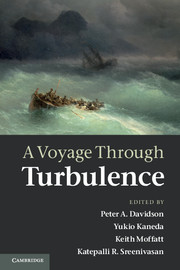Book contents
- Frontmatter
- Contents
- List of contributors
- Preface
- 1 Osborne Reynolds: a turbulent life
- 2 Prandtl and the Göttingen school
- 3 Theodore von Kármán
- 4 G.I. Taylor: the inspiration behind the Cambridge school
- 5 Lewis Fry Richardson
- 6 The Russian school
- 7 Stanley Corrsin
- 8 George Batchelor: the post-war renaissance of research in turbulence
- 9 A.A. Townsend
- 10 Robert H. Kraichnan
- 11 Satish Dhawan
- 12 Philip G. Saffman
- 13 Epilogue: a turbulence timeline
- References
4 - G.I. Taylor: the inspiration behind the Cambridge school
Published online by Cambridge University Press: 07 October 2011
- Frontmatter
- Contents
- List of contributors
- Preface
- 1 Osborne Reynolds: a turbulent life
- 2 Prandtl and the Göttingen school
- 3 Theodore von Kármán
- 4 G.I. Taylor: the inspiration behind the Cambridge school
- 5 Lewis Fry Richardson
- 6 The Russian school
- 7 Stanley Corrsin
- 8 George Batchelor: the post-war renaissance of research in turbulence
- 9 A.A. Townsend
- 10 Robert H. Kraichnan
- 11 Satish Dhawan
- 12 Philip G. Saffman
- 13 Epilogue: a turbulence timeline
- References
Summary
Opening remarks
Taylor's reputation
The obituary of G.I. Taylor (7 March 1886–27 June 1975), written by Sir Brian Pippard1 in 1975, begins thus: “Sir Geoffrey Ingram Taylor, who died at the age of 89, was one of the great scientists of our time and perhaps the last representative of that school of thought that includes Kelvin, Maxwell and Rayleigh, who were physicists, applied mathematicians and engineers – the distinction is irrelevant because their skill knew no such boundaries. Between 1909 and 1973 he published voluminously, and in a lifetime devoted to research left his mark on every subject he touched and on every one of his colleagues … his outgoing manner and complete lack of pomposity conveyed, as no formal exposition could have done, the enthusiasm and intuitive understanding that informed all his work.” These words, taken together with Pippard's closing sentence, “To his many friends he was an inspiration, at once a profound thinker and, it seemed, a truly happy man”, summarize the essential G.I. Taylor. Goldstein (1969) had this to say: “By the end of the first half-century there was a stronger and more widespread element of physics in thought and research on fluid mechanics than in the first twenty or thirty years, and this is much more so now. Several factors and several research workers contributed to this, but the greatest influence has been the example of G.I. Taylor.”
- Type
- Chapter
- Information
- A Voyage Through Turbulence , pp. 127 - 186Publisher: Cambridge University PressPrint publication year: 2011
References
- 5
- Cited by



